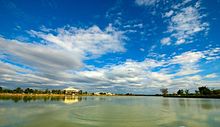Ubon Ratchathani University
มหาวิทยาลัยอุบลราชธานี (ม.อบ.) | |
 | |
| Type | Public university |
|---|---|
| Established | July 29, 1990 |
| President | Associate Professor Nongnit Teerawatanasuk, PhD |
| Location | , 15°7′4.95″N 104°54′4.95″E / 15.1180417°N 104.9013750°E |
| Campus | Urban, 8 square kilometres (2,000 acres)s |
| Colours | Blue and yellow |
| Website | www |
| File:Ubon Ratchathani University logo.jpg | |

Ubon Ratchathani University (UBU) (Thai, มหาวิทยาลัยอุบลราชธานี) was established as a campus of Khon Kaen University, Thailand, in 1987. It gained independent university status in 1990.

History
Ubon Ratchathani University was founded in 1987 as a regional campus of Khon Kaen University. It was established as a university by Royal Charter in 1990. It provides education for the people of North-East Thailand, servicing specifically the provinces of Amnat Charoen, Mukdahan, Nakhon Phanom, Sakon Nakhon, Si Sa Ket, Ubon Ratchathani and Yasothon.
The university is located on the Warin-Detudom Road, 15 kilometres south of Ubon. It is accessible by public transport from the airport and the bus terminals in Ubon, and the train station in Warin. The campus is situated in a rural setting, occupying approximately 2,100 acres (848 hectares). It has 15,000 students in 10 faculties and one college.
The university logo is in the form of a Lan Chang period chedi, a religious structure common in Esarn. The chedi contains a lotus blossom resting upon a three-tiered pedestal representing the main rivers of the province, the Mekhong, the Chii and the Moon. The two bottom petals of the blossom represent the qualities of morality and intellectuality. The three top petals represent the “Triple Gem” of Buddhism, a pathway to happiness. The pink of the lotus is the official colour of the province, and the blue outline of the logo represents the strength and stability of the university. The yellow background is the official colour of the University.
The symbolic tree of the University is the Kan-Krao, a fragrant yellow flowering tree that grows prolifically on campus. Kan-Krao can grow even in infertile soil. Its timber is very hard and can withstand termites, so it is excellent in the construction of houses and furniture. The tree represents the strength and unity of the university working towards the future.

Semester times
UBU mainly operates on a two-semester program. From 2014, semester 1 is from the beginning of August to the end of October and Semester 2 is from December to April. A summer semester from May to July is offered in some selected courses presented in intensive mode.
Scholarships
There are scholarships available for international students, especially those students from neighbouring countries.
Academic
Faculties
- Faculty of Agriculture
- Faculty of Applied Arts and Design
- Faculty of Engineering
- Faculty of Law
- Faculty of Liberal Arts
- Faculty of Management Science
- Faculty of Nursing
- Faculty of Pharmaceutical Sciences
- Faculty of Political Science
- Faculty of Science
College
International collaboration
There are Memoranda of Understanding with:
- Asian Institute of Technology (AIT), Thailand,
- Asian Pacific Social Impact Leadership Centre, Melbourne Business School, Australia,
- ASEA-UNINET - Umbrella Agreement,
- Champasack University, Laos,
- College of Aquaculture and Fisheries, Can Tho University, Vietnam,
- College of Languages, Linguistics, and Literature, University of Hawaii, USA,
- Florida State University, USA,
- Guangxi University

- Guangxi Normal University for Nationalities, China,
- Hue University, Vietnam,
- Yunnan University of Nationalities (YUN), China,
- Far East University, South Korea,
- Institute of Technology Cambodia, Cambodia,
- Korea Research Institute of Chemical Technology, South Korea,
- Mahidol University, Thailand,
- National University of Laos, Laos,
- Royal University of Agriculture, Cambodia,
- Royal University of Phnom Penh, Cambodia,
- Sathien Dhammasathan, Thailand,
- TECHNO Project

- Thai Nguyen University of Medicine and Pharmacy, Vietnam,
- The Center for Southeast Asian Studies, Kyoto University, Japan,
- The Florida State University, USA,
- Toyohashi University of Technology, Japan,
- University of Battambang, Cambodia,
- University of Danang, Campus in Kontum, Vietnam,
- University of Philippines Los Banos, Philippines,
- University of Management and Economics, Cambodia,
- University of Otago, New Zealand,
- University of Technology Sydney (UTS), Australia,
- University of Wisconsin-Madison, USA,
- University Paul Sabatier - Toulouse III, France,
- Yamaguchi University, Japan.
References
This article includes a list of references, related reading, or external links, but its sources remain unclear because it lacks inline citations. (January 2016) |
External links
- Ubon Ratchathani University (English)
- Ubon Ratchathani University (Thai)
